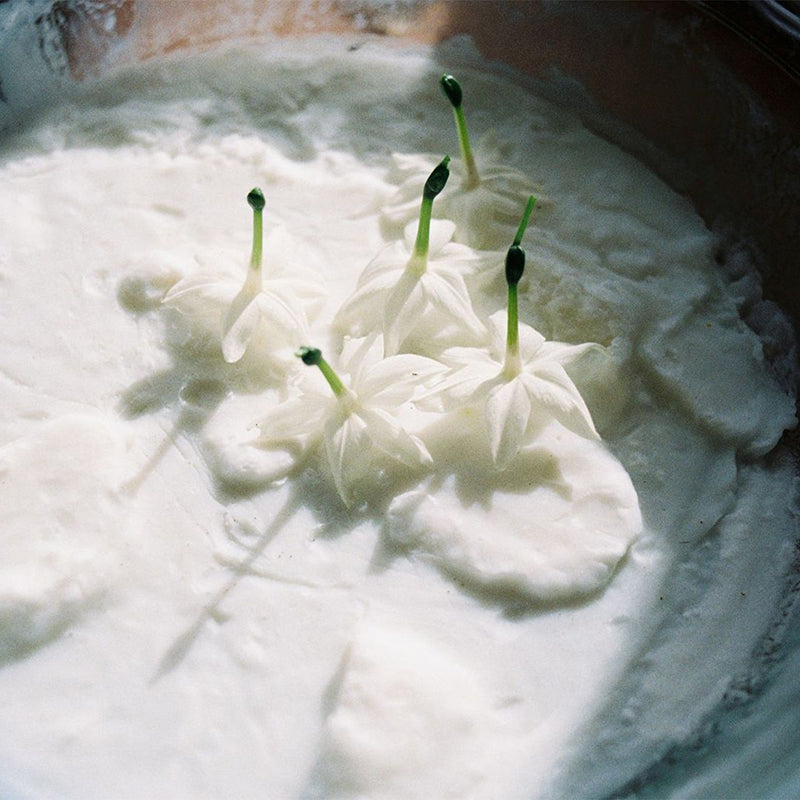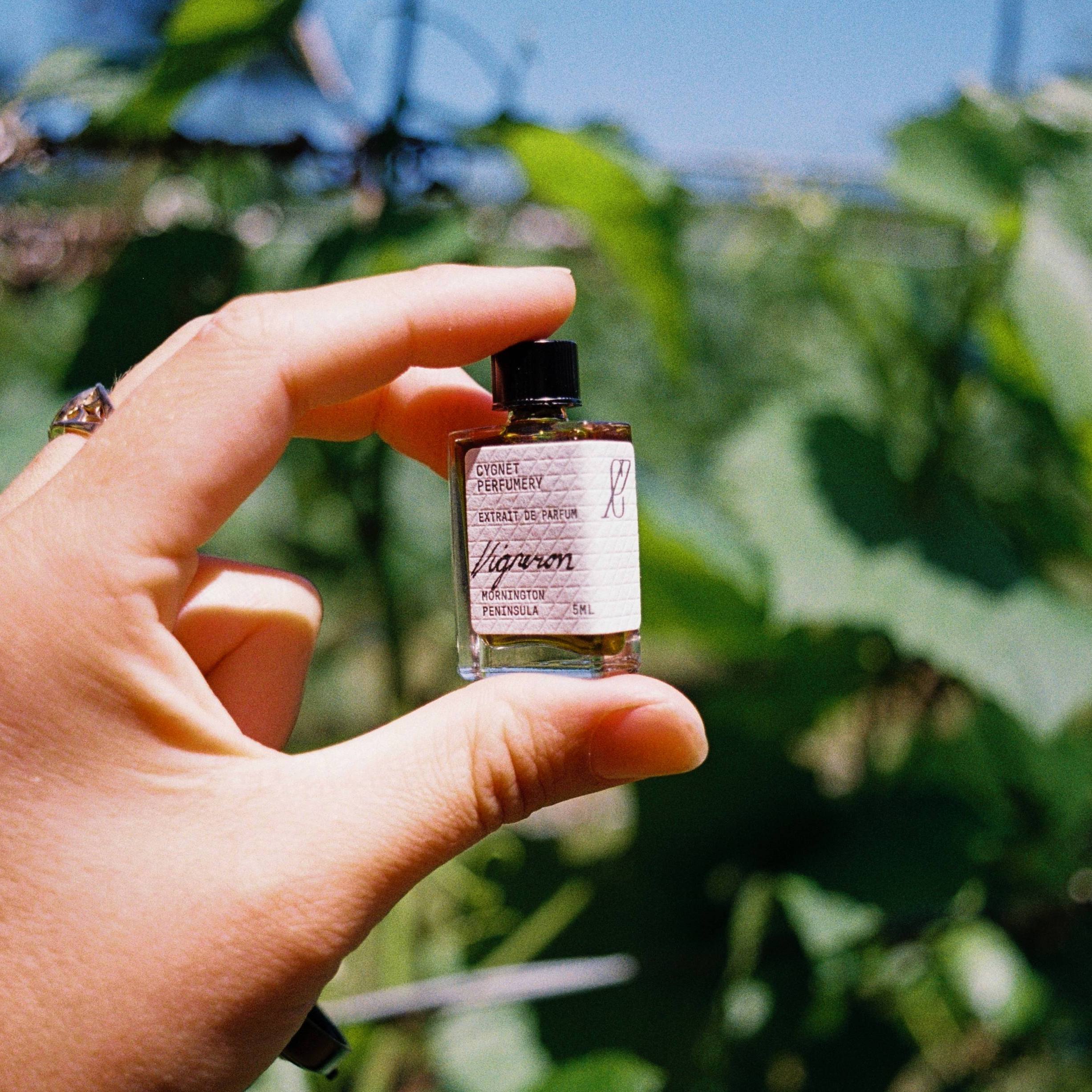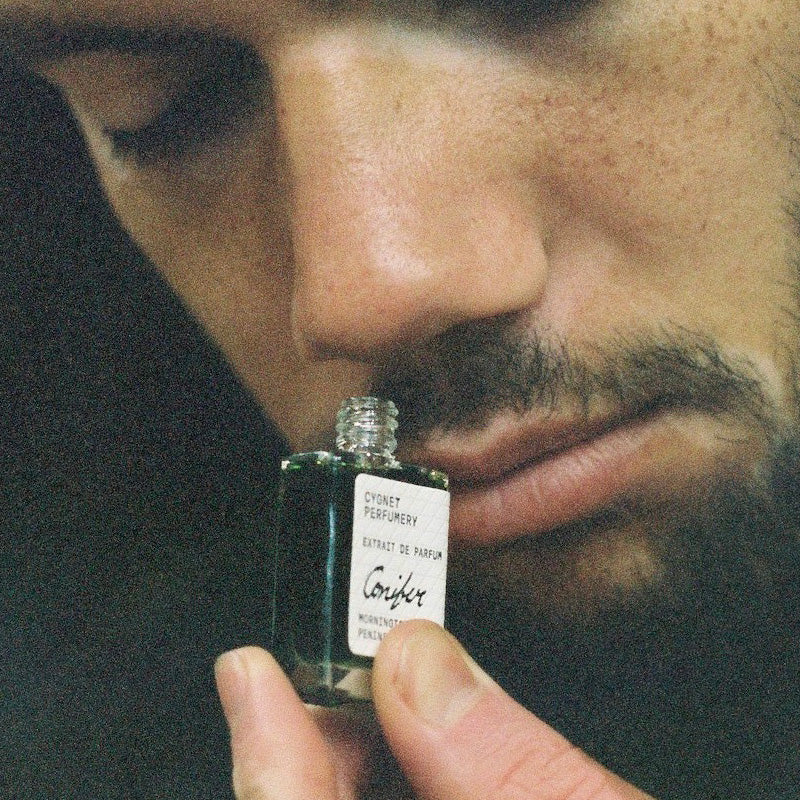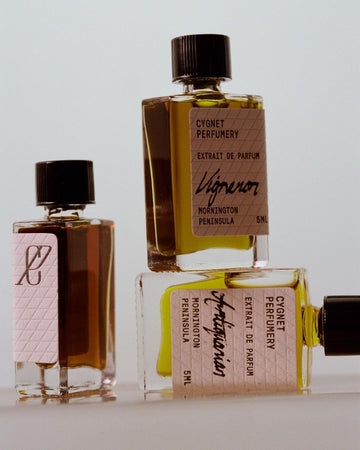AN INTERVIEW WITH BRIDGET NICHOLSON FROM GRANITE BAR ROSEMARY ARTISAN FARM & ESSENTIAL OIL DISTILLERY
Bridget Nicholson has been growing Rosmarinus Officinalis “Herb Cottage” since 2016 in Welshpool, Victoria. She follows organic methods, using only physical labour and rainwater to distil the most beautifully fragrant essential oil and hydrosol in copper alembics imported from Portugal. The hydrosol is akin to burying your nose inside a rosemary bush warmed by the sun, and is both anti-inflammatory and antibacterial. The essential oil also pertains these properties amongst other therapeutic effects, and is the most exquisite I have smelled – herbaceous, fresh and earthy with honey undertones.

In perfumery, Rosemary ct Verbenone essential oil is a top-middle note. Due to containing less camphor than other Rosemary Essential Oil chemotypes, it has a superior scent and is preferred for skincare. You may be thinking – Rosemary Essential Oil is all the same. However, their are many varieties which possess unique aromas, and unfortunately like allot of essential oils adulteration is rife.
Terroir is a French term used in winemaking, which describes how the climate, soil and terrain affect the grapes and thus the taste and characteristics of a wine. Similarly, the aroma profile and the chemotype of essential oils can vary depending on the natural conditions where it was grown, as well as the method of distillation.
The chemotype of an essential oil depends on the balance of chemical constituents. Rosemary (Rosmarinus Officinalis) is perhaps the most well-known essential oil that yields various chemotypes (ct), the main three being: Camphor ct, 1,8-Cineole ct & Verbenone ct. The latter is premium in both aroma profile and it’s cell regenerative properties for skincare. South Gippsland provides the perfect terroir for Rosmary ct Verbenone, where the cool ocean air is conducive to keeping Camphor levels low.

Sondrine: Your art often explores humans and their relationship to the environment. Do you find any crossovers with growing and distilling Rosemary, or perhaps does it compliment your practice in some way?
Bridget: Art making can be very lonely and very much in your head. Whilst I love being in that zone it can leave you feeling unconnected. I find that all parts of working with the rosemary are grounding. Spending a day weeding slows you down and makes you observant of the detail right in front of you for example. There is the slowness necessary in the time it takes for plants to grow, watching the change in seasons, all of which makes me feel very connected to nature, weather, season, bugs and all. It is also manageable and not too intrusive. I would not want to be manipulating land and cycles in a big way. I find in everything simplicity is the hardest to achieve but in my mind is perfection, so growing and working with rosemary helps to attach me, to remind me, of the need for simplicity and all the complexity which is tied up in that simplicity.

Sondrine: How does organically growing and distilling essential oils fit into the regenerative agriculture model?
Bridget: That is a very big question and I feel that we are starting right on the very edge of this and hopefully learning as we go. We are working at a very domestic level using land around the house removing grass (kikuyu) doing this both physically and with solarising. The rosemary plants don’t have a long-life cycle which means either replanting in 6-7 years or potentially changing plant type. Personally, I think the growth in scale in agriculture brought about by technology and machination has brought about a lack in biodiversity. When we were more reliant on manual labour the scale was different, now we are perhaps inadvertently altering the landscape and removing some of the complexity of the natural systems which is overall what sustains. We are just starting small with a desire to learn and be able to adapt and change along the way. The essential oil industry in Australia is growing and hopefully it can maintain the diversity in plant types and matching of plants to conditions to be able to work within and maintain biodiversity.

Sondrine: Asides from training in architecture and studying art, you also studied Aromatherapy in the 1990s. From an aromatherapist perspective, could you tell us a little bit about the therapeutic actions of Rosemary ct Verbenone?
Bridget: My training was a long time ago and aromatherapy seems quite different today to when I studied. I have read about ct Verbenone and then tested this on ourselves, so we are not scientific authorities however one of its characteristics is said to be in supporting and aiding the lungs with congestion or cold and flu type symptoms and we have put that to the test. The other is with inflammation and pain management, both skeletal and muscular. Ian used the oil daily for arthritic pain in his knees and hands and whilst it did not mean that the pain did not come back, it relieved the pain for a period of time, as he used to say “ it takes the sting out of the pain”. I have used the oil mainly in relieving muscular cramps and for soothing tiredness. The main difference between the ct Verbenone and other rosemary oil is that it is less camphorous in its smell and this I find very attractive.

Sondrine: Could you please share with us some ways Rosemary Essential Oil & Hydrosol can be incorporated into rituals at home?
Bridget: The oil I view as the great stabiliser and grounder. I rub it on the souls of aching feet, have it next to the bed to reach for when cramps occur in the middle of the night, and use for inhalations, a few drops on the top of a bowl of steaming water to be inhaled under a towel should we feel in any way congested. Ian rubs into his aching bones. The hydrosol I use daily as a toner spraying my face after the shower and before applying moisturiser. I am sure I am biased but have no doubt it has improved the suppleness and hydration in general of my skin. We put the hydrosol in an atomiser to cleanse the air in the house without it instilling a strong odour and we make a bath mix with hydrosol and Epsom slats which regularly goes in the bath to ease tiredness and soothe/hydrate the skin.

Sondrine: What are some of your dreams for your plot of land in Welshpool over the next decade?
Bridget: I hope to continue to grow and distil and always have some rosemary somewhere. I may experiment with other plants and have started this with a small patch of chamomile which I love, however I don’t think we could do this on a commercial scale. I have also tried some clay sage, as I have used the oil extensively in the past. We looked at Kunzea the Australian native, whose therapeutic properties are very similar to those of rosemary and is indigenous to our area, but neither of us particularly like the smell. I would like to work with native plants, it is a case of finding plants whose needs match our conditions and whose oil has properties which attract. The rosemary has in this way been a perfect fit. I would like to stay small, work with our land, soil weather conditions and just see where it takes us. We found it difficult when we were starting out, to find information or a community to connect with in Australia. I would like to see this area expand and to that end am going to run some very small workshops in Spring/Summer to share what we have learnt and provide an access point for people who may be interested in learning more in this area.

To find out more about Granite Bar Rosemary, or purchase their artisan-made products, you can head to their website or instagram.
Granite Bar Rosemary is one of the wonderful producers of the ingredients in our soon to be released regenerating face mist. Sign up to our newsletter to keep informed of it’s arrival.





